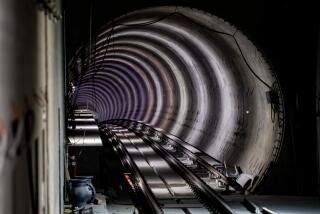Official Tries New Approach to Hold Down Costly Overruns in Subway’s 2nd Phase
Cost overruns on the first segment of the Los Angeles subway ballooned the value of construction contracts 35%. But the official who is overseeing building the next seven miles hopes to save money by learning from the mistakes.
“Shame on us if we don’t get smarter,” said Edward McSpedon, president of the Metropolitan Transportation Authority’s construction subsidiary.
McSpedon said he is trying to foster a “partnering” approach with contractors that will minimize disputes and yield a higher quality finished product. With 12% of the second phase built, McSpedon said the value of change orders is about 80% lower than during construction of the first segment.
“We’ve made a direct effort to get this claims backlog down,” said McSpedon, who took control of subway construction in July, 1990. “It helps clear up your financial obligations, and the sooner you get these things settled, the less they cost you.”
The new approach, McSpedon said, is based on a system of contract management pioneered by the Army Corps of Engineers.
“The approach has been to try to develop positive working relationships with the contractor (so) people are not coming in here with lawyers first and construction equipment second,” McSpedon said. “That doesn’t get the (taxpayers) transit systems to ride.”
McSpedon cited these steps his staff is taking to reduce change orders, the amendments that increase the value of competitively bid contracts:
* Disputes. Each major construction contract on Segment 2 has a Disputes Review Board, whose members are being chosen by the MTA and the contractor. The intent, McSpedon said, is to quickly and fairly resolve change-order disputes and to avoid litigation. On Segment 1, such boards were formed voluntarily to examine disputes on two contracts.
* Borings. Consultants are hired to drill holes in search of large boulders or otherwise uncharted obstacles before underground construction contracts are opened for bidding. McSpedon said this was in response to claims from two Segment 1 contractors who won multimillion-dollar change orders.
* Stations. On the first segment of the subway, separate contracts for excavation and finishing work were awarded for each of the five stations that are now in use. No more. Eight of the nine stations on Segment 2 will be built through a single contract. McSpedon said this was done to eliminate finger-pointing regarding construction defects.
* Computer design. Unlike for the first subway segment, design drawings are now made by computer, enabling engineers to more easily cross-reference mechanical and electrical drawings to spot inconsistencies before a contractor breaks ground.
Overall, McSpedon said, “the objectives are not to again throw money at every legal firm in town. . . . We’re going to start throwing money at building this job and getting it done quickly and safely.”
More to Read
Sign up for Essential California
The most important California stories and recommendations in your inbox every morning.
You may occasionally receive promotional content from the Los Angeles Times.











